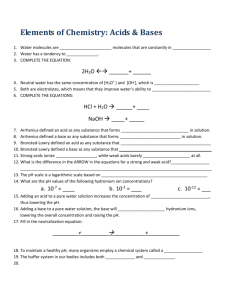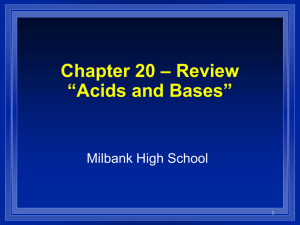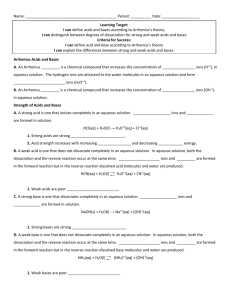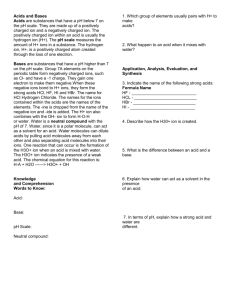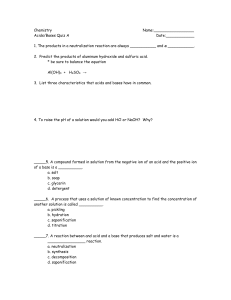Name ……………………………………………… Period …… 1. When
advertisement
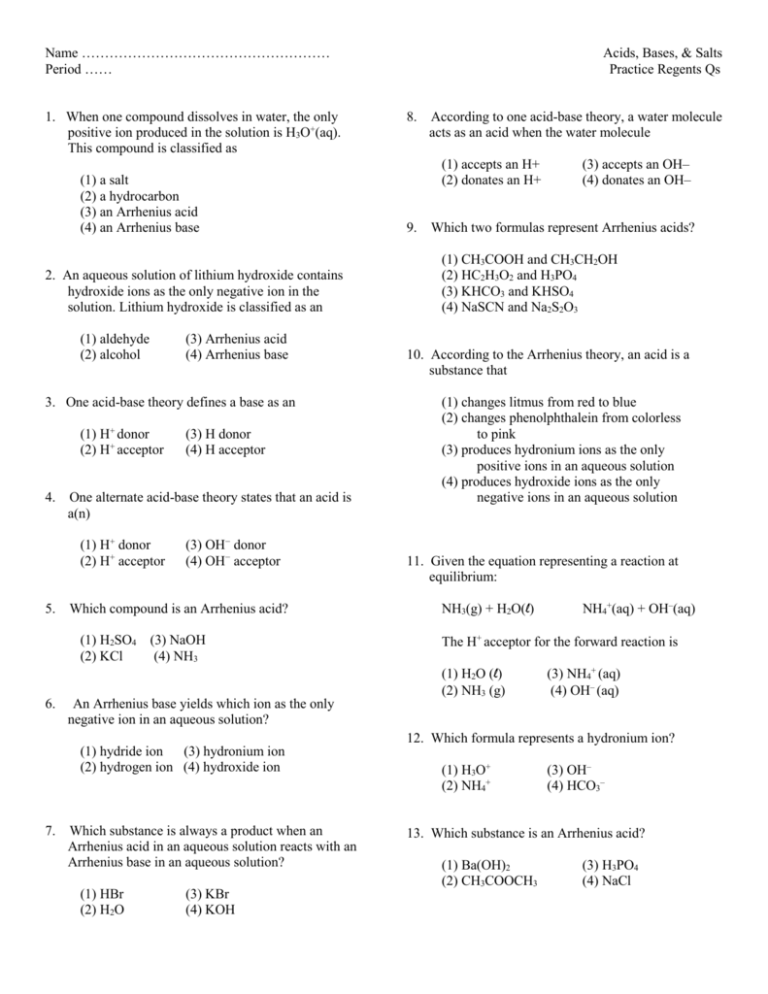
Name ……………………………………………… Period …… 1. When one compound dissolves in water, the only positive ion produced in the solution is H3O+(aq). This compound is classified as (1) a salt (2) a hydrocarbon (3) an Arrhenius acid (4) an Arrhenius base 2. An aqueous solution of lithium hydroxide contains hydroxide ions as the only negative ion in the solution. Lithium hydroxide is classified as an (1) aldehyde (2) alcohol (3) Arrhenius acid (4) Arrhenius base 3. One acid-base theory defines a base as an (1) H+ donor (2) H+ acceptor 4. One alternate acid-base theory states that an acid is a(n) (1) H+ donor (2) H+ acceptor 5. (3) H donor (4) H acceptor (3) OH− donor (4) OH− acceptor Which compound is an Arrhenius acid? (1) H2SO4 (2) KCl (3) NaOH (4) NH3 Acids, Bases, & Salts Practice Regents Qs 8. According to one acid-base theory, a water molecule acts as an acid when the water molecule (1) accepts an H+ (2) donates an H+ 9. Which two formulas represent Arrhenius acids? (1) CH3COOH and CH3CH2OH (2) HC2H3O2 and H3PO4 (3) KHCO3 and KHSO4 (4) NaSCN and Na2S2O3 10. According to the Arrhenius theory, an acid is a substance that (1) changes litmus from red to blue (2) changes phenolphthalein from colorless to pink (3) produces hydronium ions as the only positive ions in an aqueous solution (4) produces hydroxide ions as the only negative ions in an aqueous solution 11. Given the equation representing a reaction at equilibrium: NH3(g) + H2O(l) NH4+(aq) + OH–(aq) The H+ acceptor for the forward reaction is (1) H2O (l) (2) NH3 (g) 6. (3) accepts an OH– (4) donates an OH– (3) NH4+ (aq) (4) OH– (aq) An Arrhenius base yields which ion as the only negative ion in an aqueous solution? 12. Which formula represents a hydronium ion? (1) hydride ion (3) hydronium ion (2) hydrogen ion (4) hydroxide ion 7. Which substance is always a product when an Arrhenius acid in an aqueous solution reacts with an Arrhenius base in an aqueous solution? (1) HBr (2) H2O (3) KBr (4) KOH (1) H3O+ (2) NH4+ (3) OH– (4) HCO3– 13. Which substance is an Arrhenius acid? (1) Ba(OH)2 (2) CH3COOCH3 (3) H3PO4 (4) NaCl 14. Which compound releases hydroxide ions in an aqueous solution? 20. Given the equation: HCl(g) + H2O(l)→X(aq) + Cl−(aq) (1) CH3COOH (2) CH3OH (3) HCl (4) KOH 15. Given the balanced equation representing a reaction: Which ion is represented by X? (1) hydroxide (2) hydronium (3) hypochlorite (4) perchlorate NH3(g) + H2O (l) → NH4+(aq) + OH–(aq) According to one acid-base theory, the NH3(g) molecules act as (1) an acid because they accept H+ ions (2) an acid because they donate H+ ions (3) a base because they accept H+ ions (4) a base because they donate H+ ions 16. Which substance is an Arrhenius base? (1) CH3OH (2) CH3Cl (3) LiOH (4) LiCl 21. The data collected from a laboratory titration are used to calculate the (1) rate of a chemical reaction (2) heat of a chemical reaction (3) concentration of a solution (4) boiling point of a solution 22. Which word equation represents a neutralization reaction? (1) base + acid →salt + water (2) base + salt →water + acid (3) salt + acid →base + water (4) salt + water →acid + base 17. The Arrhenius theory explains the behavior of (1) acids and bases (2) alcohols and amines (3) isomers and isotopes (4) metals and nonmetals 18. The only positive ion found in H2SO4(aq) is the (1) ammonium ion (2) hydroxide ion (3) hydronium ion (4) sulfate ion 19. Which statement describes an alternate theory of acids and bases? (1) Acids and bases are both H+ acceptors. (2) Acids and bases are both H+donors. (3) Acids are H+ acceptors, and bases are H+ donors. (4) Acids are H+ donors, and bases are H+ acceptors. 23. Which reactants form the salt CaSO4(s) in a neutralization reaction? (1) H2S(g) and Ca(ClO4)2(s) (2) H2SO3(aq) and Ca(NO3)2(aq) (3) H2SO4(aq) and Ca(OH)2(aq) (4) SO2(g) and CaO(s) 24. In which laboratory process could a student use 0.10 M NaOH(aq) to determine the concentration of an aqueous solution of HBr? (1) chromatography (2) decomposition of the solute (3) evaporation of the solvent (4) titration 25. A 25.0-milliliter sample of HNO3(aq) is neutralized by 32.1 milliliters of 0.150 M KOH(aq). What is the molarity of the HNO3(aq)? (1) 0.117 M (2) 0.150 M (3) 0.193 M (4) 0.300 M 26. Which volume of 0.10 M NaOH(aq) exactly neutralizes 15.0 milliliters of 0.20 M HNO3(aq)? (1) 1.5 mL (2) 7.5 mL (3) 3.0 mL (4) 30. mL 31. What is the pH of a solution that has a hydronium ion concentration 100 times greater than a solution with a pH of 4? (1) 5 (2) 2 (3) 3 (4) 6 32. Which indicator would best distinguish between a solution with a pH of 3.5 and a solution with a pH of 5.5? (1) bromthymol blue (2) bromcresol green 27. What volume of 0.500 M HNO3(aq) must completely react to neutralize 100.0 milliliters of 0.100 M KOH(aq)? (1) 10.0 mL (2) 20.0 mL (3) 50.0 mL (4) 500. mL (3) litmus (4) thymol blue 33. The color of the indicators methyl orange and litmus are yellow and red respectively in two samples of the same solution. Which pH value is consistent with the indicator results? 28. What volume of 0.120 M HNO3(aq) is needed to completely neutralize 150.0 milliliters of 0.100 M NaOH(aq)? (1) 62.5 mL (2) 125 mL (3) 180. mL (4) 360. mL 29. Which change in pH represents a hundredfold increase in the concentration of hydronium ions in a solution? (1) pH 1 to pH 2 (2) pH 1 to pH 3 (3) pH 2 to pH 1 (4) pH 3 to pH 1 30. The pH of an aqueous solution changes from 4 to 3 when the hydrogen ion concentration in the solution is (1) decreased by a factor of 100 (2) decreased by a factor of 10 (3) increased by a factor of 100 (4) increased by a factor of 10 (1) 1 (2) 5 (3) 3 (4) 10 34. A student tested a 0.1 M aqueous solution and made the following observations: •conducts electricity •turns blue litmus to red •reacts with Zn(s) to produce gas bubbles Which compound could be the solute in this solution? (1) CH3OH (2) LiBr (3) HBr (4) LiOH 35. Which indicator, when added to a solution, changes color from yellow to blue as the pH of the solution is changed from 5.5 to 8.0? (1) bromcresol green (2) bromthymol blue (3) litmus (4) methyl orange 36. Which two compounds are electrolytes? (1) C6H12O6 and CH3CH2OH (2) C6H12O6 and HCl (3) NaOH and HCl (4) NaOH and CH3CHOH

